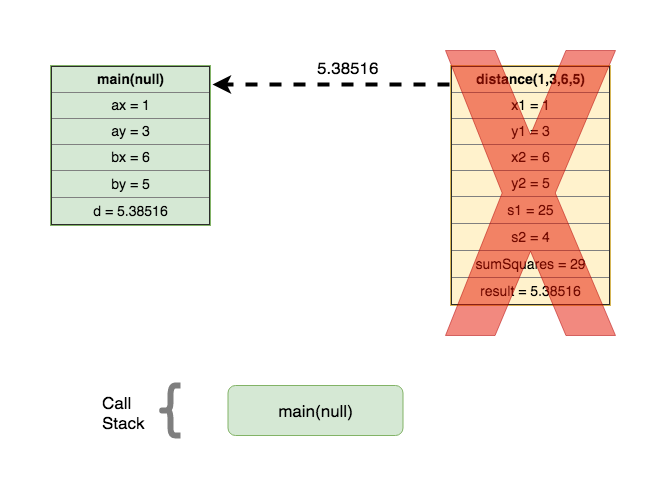Recursion - function call
Assumed Knowledge:
Learning Outcomes:
- Better understand the concept of parameter passing.
- Familiarize yourself with standard terminology - formal paramters vs. actual parameters.
- Understand the control flow and memory transactions during a function call.
- Understand the concept of Call Stack.
Author: Gaurav Gupta
Why this page is important?
Many times, we struggle to understand a concept, but do not realiZe that the actual issue is in one of the prerequisite concepts. This is especially true for recursion. An satisfactory understanding of how functions work is essential for a satisfactory understanding of recursion.
Take this example (contributed by Daniel Sutantyo), and determine the output of the program (the value displayed):
1
2
3
4
5
6
7
8
9
10
11
public class Client {
public static void main(String[] args) {
int n = 17;
update(n);
System.out.println(n);
}
int update(int n){
return n+12;
}
}
Explanation
Congratulations if your answer is 17.
If your answer was 29, read on. Note the n inside the main method and the n inside the update method are physically different variables in memory. The value returned by the update method is ignored by the main method, and the n inside main remains unchanged.
The point of the above exercise is not to make you feel bad, but rather to emphasize that before you jump into recursion, you will greatly benefit from having a strong foundation, which you can, if you study this page sincerely.
Formal parameters vs. actual parameters
- Formal parameter is the name used for the variable in the function definition.
- Actual parameter is the value copied into the formal parameter during a function call.
Consider the following example:
1
2
3
4
5
6
7
8
9
10
11
public class FormalVsActual {
public static int square(int n) { //n is the "formal parameter"
int result = n * n;
return result;
}
public static void main(String[] args) {
int a = 5;
int b = square(a); //whatever is inside the brackets is the "actual parameter"
}
}
In the above example,
- Formal parameter in function
squareisn. - Actual parameter in the function call
square(a)isa(5). - If the function call was
square(d/20 + e/9), the actual parameter would bed/4 + e/9(100/20 + 36/9 = 9).
What happens during a function call?
Before we can truly conquer recursion, it’s critical to understand what happens when a function is called. Consider the following example:
1
2
3
4
5
6
7
8
9
10
11
12
13
14
15
16
17
18
19
public static void main(String[] args) {
int ax = 1, ay = 3;
int bx = 6, by = 5;
double d = distance(ax, ay, bx, by);
System.out.println("Distance: "+d);
}
public static double distance(int x1, int y1, int x2, int y2) {
int s1 = square(x2-x1);
int s2 = square(y2-y1);
int sumSquares = s1 + s2;
double result = Math.sqrt(sumSquares);
return result;
}
public static int square(int num) {
int answer = num * num;
return answer;
}
STEP 1: main function is invoked by JVM

function call is placed on the stack. Note that parameter is null because we typically do not pass any arguments to main, at least in this unit.
STEP 2: main function calls distance with parameters 1, 3, 6 and 5.

Another entry is made for the call to distance and placed on the call stack.
STEP 3: distance calls square with parameter 5

A third entry is made for the call to square and placed on the stack.
STEP 4: square returns 25 to distance

Entry for square is taken off the stack. distance becomes the active function.
STEP 5: distance calls square with parameter 2

A third entry is made for the call to square and placed on the stack.
STEP 6: square returns 4 to distance

Entry for square is taken off the stack. distance becomes the active function.
STEP 7: distance calls Math.sqrt with parameter 29

A third entry is made for the call to Math.sqrt and placed on the stack.
STEP 8: Math.sqrt returns 5.38516 to distance

Entry for square is taken off the stack. distance becomes the active function.
STEP 9: distance returns 5.38516 to main

Entry for distance is taken off the stack. main becomes the active function.
STEP 10: main terminates
Entry for main is taken off the stack. Call stack is now empty. Program has now finished execution.
Summary of control flow
